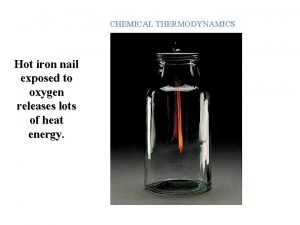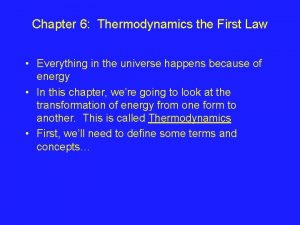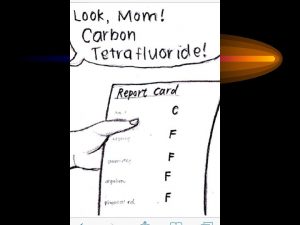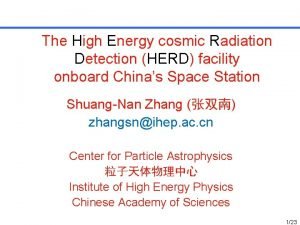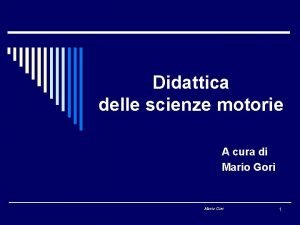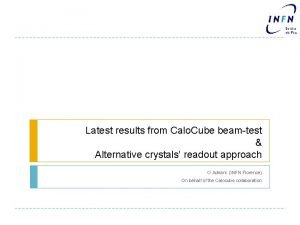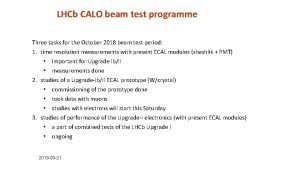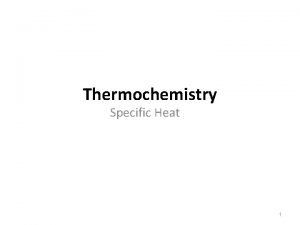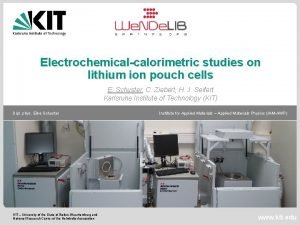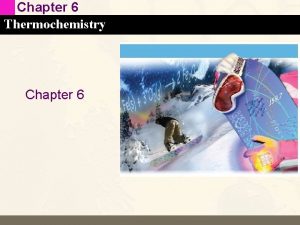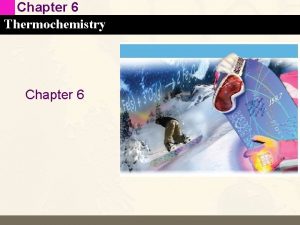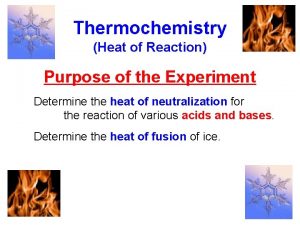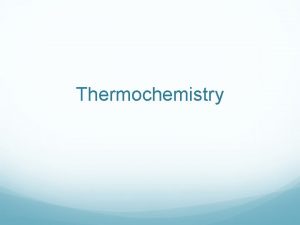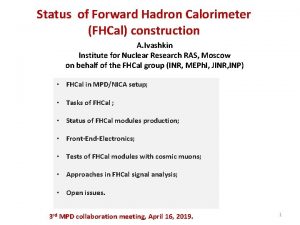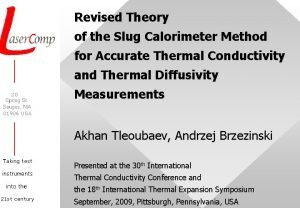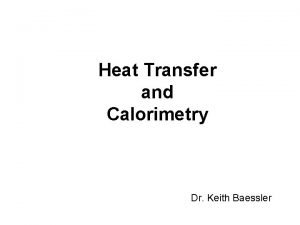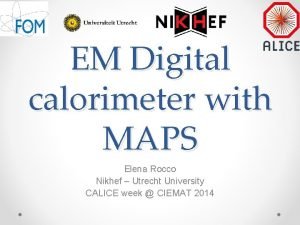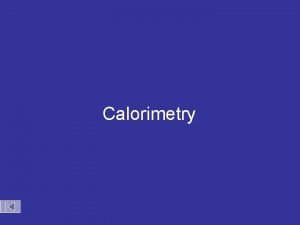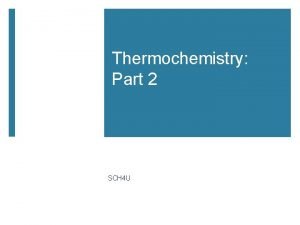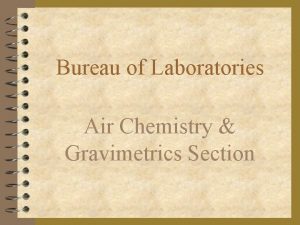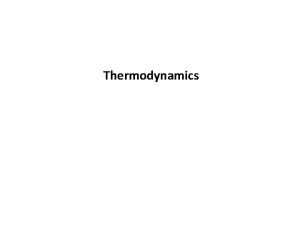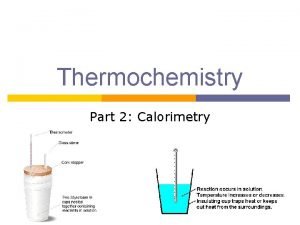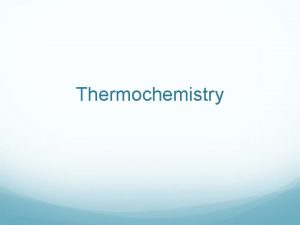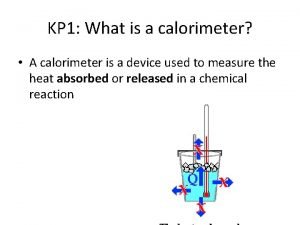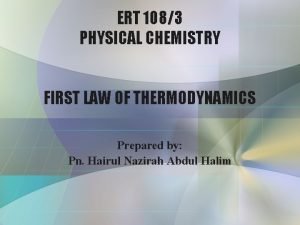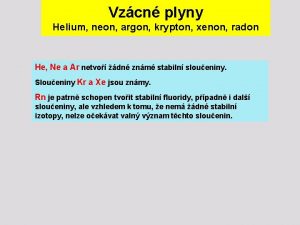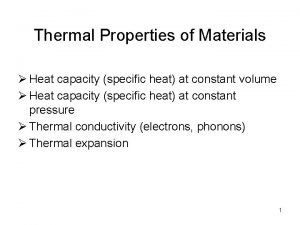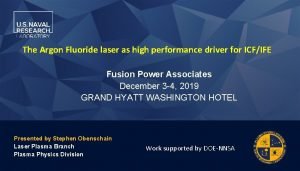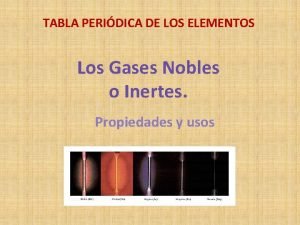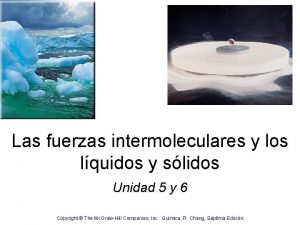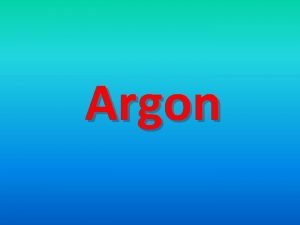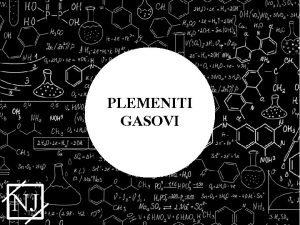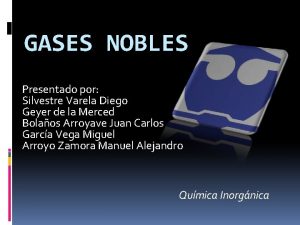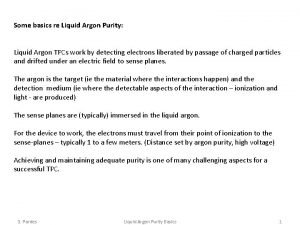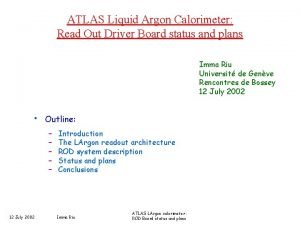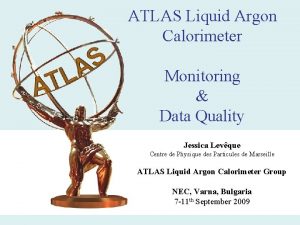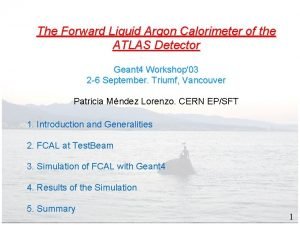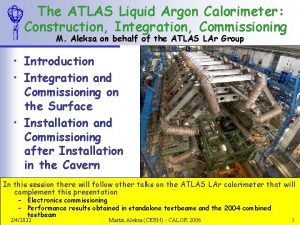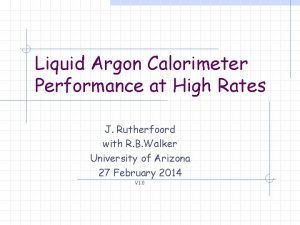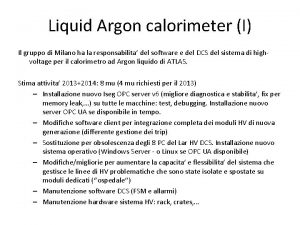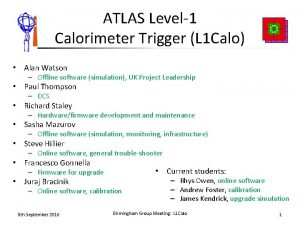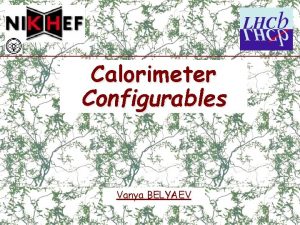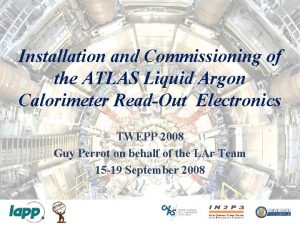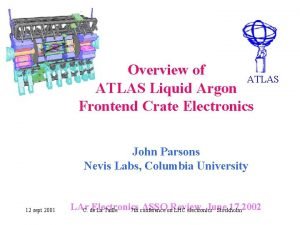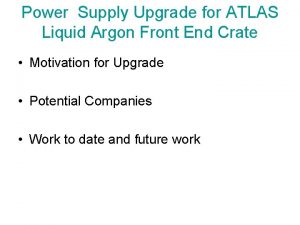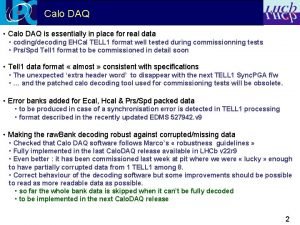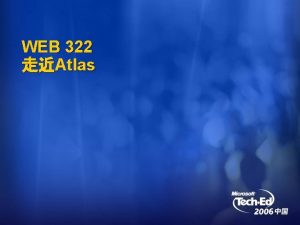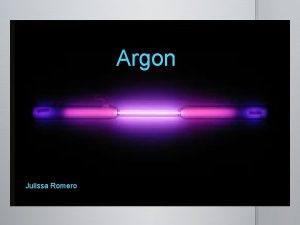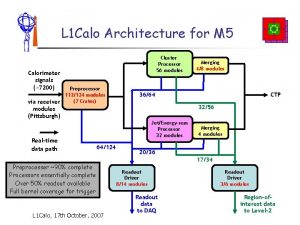The ATLAS Liquid Argon Calorimeter and early calo

















































- Slides: 49

The ATLAS Liquid Argon Calorimeter and early calo based results Huaqiao ZHANG Michigan State University, USA

Introduction • What is High Energy physics 6/12/2021 Huaqiao ZHANG (MSU) 2

Particles 6/12/2021 Huaqiao ZHANG (MSU) 3

Why LHC Symmetry or Asymmetry? • Gauge invariance Higgs mechanism The reason we build LHC : Mass origin 6/12/2021 Huaqiao ZHANG (MSU) 4

What can we do on LHC • • EW precision measurement Extra Dimension Black hole SUSY You may find others and Exotic won the Nobel price of 2011 Dark matter candidates Quark gluon plasma Jet quenching – Dijet asymmetry found this month 6/12/2021 Huaqiao ZHANG (MSU) 5

• WWW => Grid 6/12/2021 Life at LHC Huaqiao ZHANG (MSU) 6

LHC status LHC: Large Hadron Collider at CERN 27 Km tunnel, 100 m underground Collision: P-P or Pb-Pb Ecm: 7 Te. V for P-P(Designed 14 Te. V) 2. 76 Ge. V for Pb-Pb Instantaneous luminosity: 2*1032 for P-P now(Designed 1034) Bunch crossing: 150 ns Now, (Designed 25 ns) 3/2010 -11/2010 P-P; 11/2010 -12/2010 Pb-Pb Next Year: 3/2011(? ) start P-P at >=7 Te. V, goal is 2*1032, decide next month 6/12/2021 Huaqiao ZHANG (MSU) 7

Data Collection 6/12/2021 Huaqiao ZHANG (MSU) 8

ATLAS Detector 6/12/2021 Huaqiao ZHANG (MSU) Length : ~ 46 m Radius : ~ 12 m Weight : ~ 7000 tons ~108 electronic channels 3000 km of cables 9

ATLAS Detector Physical Goal: precision electroweak theory tests, Higgs Hunting and Physics beyond standard model 6/12/2021 Physics related to Calo: W, Z, top, Higgs, SUSY… Requirements to Calorimeter: Good ability of e/g ID and energy measurement for e/g, jets/Etmiss Huaqiao ZHANG (MSU) 10

What are detectors doing 6/12/2021 Huaqiao ZHANG (MSU) 11

What is a experimental physicist doing • Hardware => these blinds • Physics objects => parts of the elephant • Physics => the elephant 6/12/2021 Huaqiao ZHANG (MSU) 12

Calo hardware and performance 6/12/2021 Huaqiao ZHANG (MSU) 13

ATLAS LAr Calorimetry (1) • Sampling Calorimeter, Full phi coverage • EM part|η|<3. 2 [Pb-LAr] • Hadronic End-cap: 1. 5<|η|<3. 2 [Cu-LAr] • Forward Calorimeter: 3. 1<|η|<4. 9 [Cu, W-LAr] • Test beam: 2001 -2004 • Cosmics data: 2006 -2009 • Sept. 2008, single beam data • Pp Collision data: Since Nov. 2009 • Pb-Pb collison data since Nov. 2010 6/12/2021 Huaqiao ZHANG (MSU) 14

ATLAS LAr Calorimetry (2) • EM (EMB+EMEC) – Pre-sampler: Recover energy deposited before Calo • | η |<1. 8, 0. 025*0. 1 – Strips: Fine η granularity ensure good gamma/pi separation • | η |<3. 2, typical 0. 003*0. 1 – Middle: Most EM energies deposited • | η |<3. 2, typical 0. 025*0. 025 – Back: Recover e/g longitudinal energy leakage • HEC • |η| <2. 5, 0. 05*0. 025 – Four layers: 1. 5<|η| <2. 5, 0. 1*0. 1; 2. 5<|η| <3. 2, 0. 2*0. 2 • FCAL – Three layers, 3. 1 <|η| <4. 9, Non projective • Fine Granularity and multi-layer at |η|<2. 5 ensure accurate e/g id and energy reco. • Grosser Granularity at High η region sufficient for Jet/Etmiss measurements • LArg: 0. 0186% of unrecoverable channels • 1. 4% of dead readout channels, EM: 1. 5%, HEC: 0. 1% FCAL: 0% (04. 05. 2010) • Including ~20 Dead Optical Transmitters (will be fixed when detector is opened) 6/12/2021 Totally ~180 K Huaqiao cells, 98. 6 operational ZHANG% (MSU) 15

Is this physics or detector effects? 6/12/2021 Huaqiao ZHANG (MSU) 16

LAr Calorimeter HV Status • All HV at nominal but 6% reduced • Energy Corrections depends on the HV setting and the cell geometry • Correction factor based on test beam results HV is well treated across all the LAr detector 6/12/2021 Huaqiao ZHANG (MSU) 17

LAr temperature and purity RMS of each probe • LAr temperature – – • LAr signal sensitivity 2%/K (density: -0. 45%/K , Velocity: -1. 55%/K) Require 100 m. K stability and homogeneity Using 150 -200 PT 100 probes in each cryostats immersed in liquid argon Homogeneity 59 mk, with 1. 5 mk RMS for each probe over 10 days LAr purity – – 6/12/2021 Electronegative impurities would reduce the measured signal Require purity better than 1000 ppb 30 purity monitors in the three cryostats Measured impurity: Barrel ~ 200 ppb, End. Cap ~ 140 ppb ZHANG (MSU) Well within required. Huaqiao 0. 2% uncertainties of signal 18

LAr Calorimeter pulse shape and drift time CR-(RC)2 E The RTM(FPM diff. ) method : Prediction depend on the knowledge of drift time measurement Accuracy of pulse shape better than 2% 6/12/2021 Huaqiao ZHANG (MSU) 19

Readout Electronic Performance • Take Electronic Calibrations runs up to every fill • Update the calibration constants every week • Reprocessing data with closest electronic calibration runs. • Long term stability of Calibration constants checked Very good electronics stability Pedestal difference w. r. t. a reference run in 6 months ATLAS preliminary 6/12/2021 RMS=0. 0248 Typical Pedestal ~1000 ADC Huaqiao ZHANG (MSU) 20

Timing alignment • L 1 Calo Trigger timing: – Align the timing for all Trigger Tower to give the on-time L 1 Acceptance – Mainly affect the trigger efficiency – LHC distributed timing drift due to temperature effects – Corrected use BPTX as reference – Better within 1 ns now • LAr. Calo timing: – Align the timing from L 1 Acceptance to offline readout slot (achieved since cosmics data), up to 1 ns accuracy – Mainly affect the online energy reco. – Using collision events to calculate the timing delays, cross check with data Timing of the LAr. Calo at sub ns level 6/12/2021 Huaqiao ZHANG (MSU) 21

Calo based physics objects performance 6/12/2021 Huaqiao ZHANG (MSU) 22

L 1 EM Calo Trigger performance • L 1 Calo - LAr offline: Same detector, different readout, different granularity At granularity 0. 1*0. 1 L 1 Calo works as expected L 1 EM 5: Et > 5 Ge. V Step of 1 Ge. V Designed constant term: 5% Rates 6/12/2021 Huaqiao ZHANG (MSU) 23

HLT Calo trigger performance EF_xet 20 6/12/2021 Huaqiao ZHANG (MSU) Good performance w. r. t. offline of eg, tau, jets, MET 24

Trigger menu evolution • In 2010: Physicist did not care too much about trigger, since trigger threshold are very low, trigger id cuts are very loose • Next year: the first thing you should consider for your physics channel is that: my signal will be biased/killed at trigger level? • 6/12/2021 High threshold, slow turn on, isolation… Huaqiao ZHANG (MSU) 25

Missing ET in random Events LAr sub-detectors only: Check Noise modeling Noise monitored online • A dynamical topological cluster algorithm with seeds >4 noise and neighbor > 2 noise • Better Noise suppression • Close to the final choice of Et miss calculation LAr Noise well modeled by Gaussian topo cluster has better noise suppression 6/12/2021 Huaqiao ZHANG (MSU) 26

Missing Et in collisions 6/12/2021 Huaqiao ZHANG (MSU) 27

Jets reconstruction and energy scale • Jet reconstructed from “topological clusters” • Jet momenta corrected for -calorimeter non-compensation -dead material, etc. using η/p. T-dependent calibration factors derived from MC ( tuned with “combined testbeam” data ) • Result checked with single particles /Min bias Today JES known to : ~ 7% Ultimate goal: ~1% Inter-calibration central-forward checked using jet p. T-balance

Egamma: Electrons Electron recon and ID: -energy from calibrated cluster -angles from track 3 levels of electron ID: -loose( rough shower shape and track) -medium: ref shower shape, pixel hit, a 0 -tight: track match, TRT, E/P Tight (>20 Ge. V)rejection/jets up to 105 6/12/2021 Huaqiao ZHANG (MSU) 29

Calo based physics p. T(μ)= 51 Ge. V p. T(e)=66 Ge. V p. T (b-tagged jets) = 174, 45 Ge. V ETmiss = 113 Ge. V, Secondary vertices: -- distance from primary vertex: 4 mm, 3. 9 mm -- vertex mass = ~2 Ge. V, ~ 4 Ge. V • I only concentrate on Top physics 6/12/2021 Huaqiao ZHANG (MSU) 30

Top resume • First found in 1995 • Mt = 173. 3 Ge. V – Tevatron at 5. 6 fb-1 – Heaviest lepton ever found • τt ≈ 5*10 -25 s << τhad – No bound states • |Vtb| ≈ 0. 999 – ~100% t Wb 6/12/2021 Huaqiao ZHANG (MSU) 31

Top physics • Cross sections: First ATLAS Top paper: Top pair cross section measurement at 2. 9 pb-1 – Top pair, single top • Top Properties: – mass, width, spin, charge, W-boson helicity… • Couplings: – Vtb(t Wb), Yt(tt. H, t Hq), FCNC(t Zq) • Backgrounds for physics: – Diboson, Higgs, SUSY…. • Help improve Detector performance: – Control sample for b-tag… 6/12/2021 Huaqiao ZHANG (MSU) 32

Top pair production at LHC • Total cross section – 164. 6+11. 4 -15. 7 pb @sqrt(s)=7 Te. V • 85% gg fusion • 15% qqbar animation 6/12/2021 Top pair cross section as a function of Ecm What is NNLL doing? Huaqiao ZHANG (MSU) 33

Top pair cross section measurement Lepton + jets channel Di-lepton channel • • 1 isolated lepton p. T > 20 Ge. V ETmiss > 20 Ge. V, ETmiss + m. T(W) > 60 Ge. V • • ≥ 4 jets p. T > 25 Ge. V ≥ 1 b-tag jet • • • 2 opposite-sign leptons: ee, eμ, μμ both leptons p. T > 20 Ge. V ≥ 2 jets p. T > 20 Ge. V ee: ETmiss > 40 Ge. V |M(ee)-MZ|> 5 Ge. V μμ: ETmiss > 30 Ge. V |M(μμ)-MZ|> 10 Ge. V eμ: HT = ΣET (leptons, jets) > 150 Ge. V ν 6/12/2021 Huaqiao ZHANG (MSU) e, μ 34

Lep+jets background estimation(1) • Data driven estimation – W+jets; QCD multi-jets • MC simulation: – Single Top; Z+jets; Diboson QCD multi Jets estimation e + Jets: mu + Jets: e from QCD non-prompt e mu from QCD non-prompt muon pi fake and gamma conversion Template fit of MT(W) 6/12/2021 Huaqiao ZHANG (MSU) 35

Lep+jets background estimation(2) W +Jets estimation 6/12/2021 Huaqiao ZHANG (MSU) 36

Dilepton background estimation(1) • Data driven estimation(ee, mm) – W+jets; Z(ll)+jets • MC simulation: – Single Top; Z(ττ)+jets; Diboson W+jets estimation (MM) 6/12/2021 Huaqiao ZHANG (MSU) 37

Dilepton background estimation(2) Z +Jets estimation 6/12/2021 Huaqiao ZHANG (MSU) 38

Uncertainties and combinations • Systematics considered: • Lepton reco, ID, trigger; JES; b-tagging; Background normalization; Single simulation; integrated luminosity • Dominate uncertainties • Lepton + jets: Bkg Rates(~10 -~30 %), Lumi(~10%), Stat. (30 -40%) • Dilepton: Bkg Rates(~20 -~30%), Lumi(~10%), Stat. (~100%) 6/12/2021 Huaqiao ZHANG (MSU) 39

Top cross section results @ 7 Te. V 6/12/2021 Huaqiao ZHANG (MSU) 40

Summary • LHC opened a new energy era, many physics topics could be checked in the following years • ATLAS LAr Calo shows good performance, and has many potential to explore physics at LHC • Welcome to particle physics zoo 6/12/2021 Huaqiao ZHANG (MSU) 41

Thanks 6/12/2021 Huaqiao ZHANG (MSU) 42

Test. Beam VLE electron 6/12/2021 Huaqiao ZHANG (MSU) 43

LAr Energy Flow Occupancy Map of second layer 2009 (0. 5 M) 2010 (5 M) • Good data quality run used • All cells except noisy ones Collision signal visible, data/MC agrees Cabling inversion found in Energy flow map and fixed in 2010 collisions 6/12/2021 Huaqiao ZHANG (MSU) 44

LAr Monitoring • Except when explicitly mentioned, the plots shown here are routinely produced by tier 0 and were taken from this tier 0 output. They are however also available online and typical time scale to reach the accuracy needed to get meaningful plots are of the order of few minutes of cosmic runs (depending on the trigger rates of course). 6/12/2021 Huaqiao ZHANG (MSU) 45

ATLAS trigger System Calorimeters Other Muons detectors L 1 6/12/2021 trigger L 1 A. 75 k. Hz CTP <2. 5 s ROD ROD Ro. IB L 2 SV Software L 2 N Level-2 <40 ms 120 Gb/s Ro. I requests Ro. I Data L 2 A. 2 k. Hz ROB ROB ROS 3 Gb/s Event Builder Full events ~1 s Event Filter High-level Trigger Huaqiao ZHANG (MSU) EF Acc. 200 Hz EFN 300 Mb/s 46 DAQ trigger Regions of Interest (Ro. I) ~500 dual CPUs Full granularity Regions of Interest (~2%) Latency ~40 ms L 2 A 2 k. Hz ~1600 dual CPUs Access to full event & calibration constants More detailed reconstruction Use Offline algorithms Latency ~4 s 200 Hz MUONS Level-1 L 2 Event Filter (L 3) CALO Det. readout 40 MHz hardware Dedicated hardware (ASICS & FPGAs) Calorimeters & muons Latency < 2. 5 s L 1 A 75 k. Hz

Detector Geometry HLT Calo Architecture Conditions data : LAr pulse Tile pulse Optimal Filter, pedestal, shape (Single phase) thresholds energy / cell FEB sums Byte. Stream DSP F tch /E 2 L LAr. Decoder Cells energies FEB energis Tile. Decoder Cells energies MBTS Control Error codes Region Selector ROB Data. Access Output Data organization ta a d LAr Cells Tile Cells MBTS FEB Sums Fe HLT Calo Algorithms L 2/EF Trigger Hypos egamma tau jet Feb Jet MET Tile. Mu Monitoring 6/12/2021 Huaqiao ZHANG (MSU) 47

ATLAS Worldwide Grid Computing Tier 0 (CERN): first processing Tiers 1: reprocessing , simulation , data storage for analyses MB/s Jan 6 GB/s MC reprocessing Feb March Start of 7 Te. V data-taking April May Data and MC reprocessing June Start of 1011 p/bunch operation July August LHC multi-bunch operation 2009 data reprocessing ~2 GB/s (design) Peaks of 10 GB/s achieved GRID-based analysis in Summer 2010: > 1000 different users, > 15 million analysis jobs processed

Mapping the Inner Detector material with γ e+e- conversions and hadron interaction Pixel 2 Beam pipe Pixel 1 Reconstructed conversion point in the radial direction of γ e+e- from minimum bias events (sensitive to X 0) Pixel support structures Pixel 3 π0 Dalitz decays Goal is to know material to better than 5% (e. g. for W-mass measurement) Present understanding: at the level of ~ 10% SCT 1 SCT 2
 Calorimeter problems
Calorimeter problems Coffee cup calorimeter vs bomb calorimeter
Coffee cup calorimeter vs bomb calorimeter Constant volume calorimeter
Constant volume calorimeter Find the number of moles of argon in 452 g of argon.
Find the number of moles of argon in 452 g of argon. Language
Language Menopausa precoce sintomi iniziali
Menopausa precoce sintomi iniziali Calo
Calo Assenza ciclo mestruale conseguenze
Assenza ciclo mestruale conseguenze Calo del desiderio femminile cause ormonali
Calo del desiderio femminile cause ormonali Hidra calo
Hidra calo Calo demografico italia cause
Calo demografico italia cause Calo test
Calo test Pure liquid dielectrics example
Pure liquid dielectrics example Early cpr and early defibrillation can: *
Early cpr and early defibrillation can: * Sieve tray tower
Sieve tray tower Specific heat equation units
Specific heat equation units Constant volume calorimeter
Constant volume calorimeter Selma abdul
Selma abdul Accelerating rate calorimeter
Accelerating rate calorimeter Thermochemistry notes
Thermochemistry notes Constant volume calorimeter
Constant volume calorimeter Coffee cup calorimeter equation
Coffee cup calorimeter equation Combustion reaction
Combustion reaction Bomb calorimeter
Bomb calorimeter Hadron calorimeter
Hadron calorimeter Slug calorimeter
Slug calorimeter Calorimeter
Calorimeter Elena rocco
Elena rocco Calorimeter
Calorimeter Bomb calorimeter uses
Bomb calorimeter uses Calorimeter unit
Calorimeter unit Parr calorimeter
Parr calorimeter Calorimeter formula
Calorimeter formula Function of bomb calorimeter
Function of bomb calorimeter Bomb calorimeter
Bomb calorimeter How does a calorimeter work
How does a calorimeter work Calorimeter
Calorimeter Calorimeter constant
Calorimeter constant Neon argon krypton xenon radon
Neon argon krypton xenon radon Dulong and petit law
Dulong and petit law Argon fluoride laser could practical fusion
Argon fluoride laser could practical fusion Neon propiedades
Neon propiedades Fuerza intermolecular
Fuerza intermolecular Cl bohr model
Cl bohr model Ac symbol chemiczny
Ac symbol chemiczny Tignom
Tignom племенити гасови
племенити гасови K bohr diagram
K bohr diagram Elementos gases
Elementos gases Gas mulia
Gas mulia

